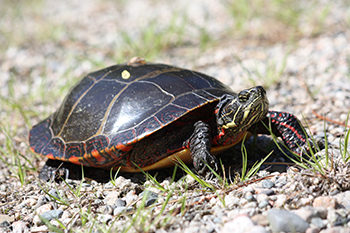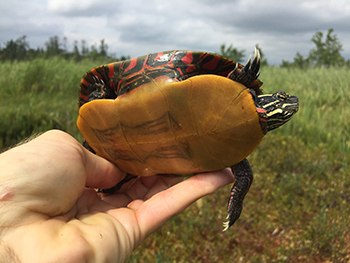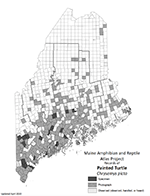Home → Fish & Wildlife → Wildlife → Species Information → Reptiles & Amphibians → Painted Turtle
Painted Turtle
Chrysemys picta
On this page:

Photo: Trevor Persons
Distinguishing Characteristics

Photo: Trevor Persons
- Medium-sized, carapace (upper part of shell) approximately 4.5 to 7 inches in length
- Smooth carapace is dark olive with distinct light borders between the scutes (individual plates on shell); scutes along the border of the carapace have yellow or dark red markings
- Large carapace scutes are more-or-less aligned across the back
- Plastron (bottom part of shell) is pale yellow, occasionally with a dark central blotch
- Limbs are dark olive green to black with bright red and yellow stripes
Status and Distribution in Maine
- Common and secure
- Statewide, except absent from northwestern Maine
Habitat
- Permanent water with submerged vegetation and plentiful basking areas
- Shallow ponds, marshes, bogs, or slow streams
Diet
- Omnivorous. Eats aquatic insects, snails, crayfish, vegetation, and carrion
Seasonal Changes
- Hibernates in muddy bottom sediments of lakes and ponds
Natural History Notes
- Named for its bright coloration of yellows, greens, reds, and black
- Sometimes called the “sun turtle” because it spends so much time basking on logs
- Sleeps on the bottoms of ponds or in shallow water areas among vegetation
Share Your Sighting
There is much still to learn about the distribution and ecology of Maine’s herpetofauna, and we encourage members of the public to share their photo-documented observations as part of the Maine Amphibian & Reptile Atlas Project (MARAP).
To see if a township still needs documentation of a species, consult this distribution map (PDF). If a township lacks a photo or specimen record, we want your observation!
There are two ways to share your observations:
Submit your reptile or amphibian observation online
No service? No problem. Click here to download the survey to your device while connected, then take offline to collect observations from anywhere. Tip: The survey works best on Google Chrome and Safari.
Or upload sightings to the iNaturalist citizen science project through their website at iNaturalist.org or mobile app.
- When submitting an observation through iNaturalist add a description of the location (and other noteworthy information) to the “notes” field. This serves as a check on the locations automatically generated by smartphone cameras, which may be imprecise if cell service or GPS coverage is weak.
Thank you for doing your part to help conserve Maine’s reptiles and amphibians.
